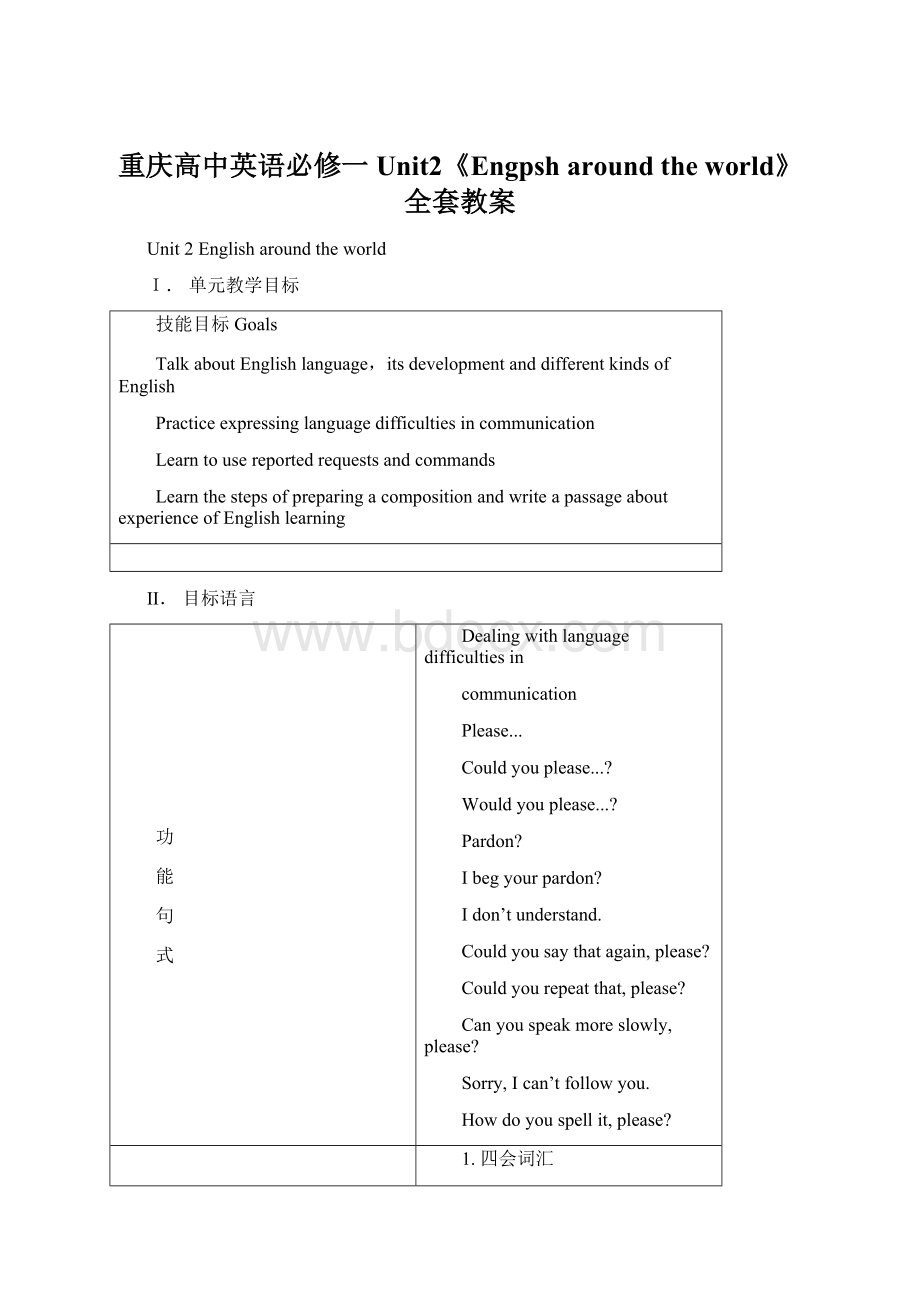重庆高中英语必修一Unit2《Engpsh around the world》全套教案.docx
《重庆高中英语必修一Unit2《Engpsh around the world》全套教案.docx》由会员分享,可在线阅读,更多相关《重庆高中英语必修一Unit2《Engpsh around the world》全套教案.docx(32页珍藏版)》请在冰豆网上搜索。

重庆高中英语必修一Unit2《Engpsharoundtheworld》全套教案
Unit2Englisharoundtheworld
I.单元教学目标
技能目标Goals
TalkaboutEnglishlanguage,itsdevelopmentanddifferentkindsofEnglish
Practiceexpressinglanguagedifficultiesincommunication
Learntousereportedrequestsandcommands
LearnthestepsofpreparingacompositionandwriteapassageaboutexperienceofEnglishlearning
II.目标语言
功
能
句
式
Dealingwithlanguagedifficultiesin
communication
Please...
Couldyouplease...?
Wouldyouplease...?
Pardon?
Ibegyourpardon?
Idon’tunderstand.
Couldyousaythatagain,please?
Couldyourepeatthat,please?
Canyouspeakmoreslowly,please?
Sorry,Ican’tfollowyou.
Howdoyouspellit,please?
词汇
1.四会词汇
include,role,international,native,elevator,flat,apartment,rubber,petrol,gasmodern,culture,AD,actually,present,rule,vocabulary,usage,
identity,government,Singapore,Malaysia,rapidly,phrase,candy,lorry,command,request,retell,politeboss,standard,eastern,Spanish,
midwestern,southeastern,northwestern,accent,recognize,lightning,direction,ma’am,subway,block
2.认读词汇
Shakespeare,NoahWebster,Lori,dialect,Houston,Texas,Buford,Lester,catfish
3.词组
playarolein,becauseof,comeup,suchas,playapart(in),inthe1600’s,givecommands
4.重点词汇
actually,elevator,native,apartment,vocabulary,include,usage,present,international,rapidly,block
语法
DirectandIndirectSpeech
(2)——Requests
andCommands
He/sheasked...(not)todo...
He/sheordered/told...(not)todo...
重
点
句子
1.WorldEnglishescomefromthosecountrieswhereEnglishplaysanimportantroleasafirstorsecondlanguage,eitherbecauseofforeignruleorbecauseofitsspecialroleasaninternationallanguage.P9
2.NativeEnglishspeakerscanunderstandeachothereveniftheydon’tspeakthesamekindofEnglish.However,theymaynotbeabletounderstandeverything.P9
3.ItbecamelesslikeGerman,andmorelikeFrenchbecausethosewhoruledEnglandatthattimespokeFrench.P10
4.TodaythenumberofpeoplelearningEnglishinChinaisincreasingrapidly.P10
5.Believeitornot,thereisnosuchathingasstandardEnglish.P13
6.TheUSisalargecountryinwhichmanydifferentdialectsarespoken.P13
7.Infact,anEnglishdictionarylikethekindyouusetodaywasn’tmadeuntilthetimeoftheQingDynasty.P51
8.Theremenspentnearlyalloftheirlivestryingtocollectwordsfortheirdictionaries.P51
9.Attheageoffourteen,helefthisvillageschoolinScotlandandtaughthimselfwhileworkinginabank.P52
10.Weknowthatlanguagesdevelopandchangeovertimeandthatiswhywehavenewdictionariesfromtimetotime.P52
III.教材分析与教材重组
1.教材分析
本单元以“世界英语”为中心话题,旨在通过本单元的学习让学生粗略了解世界英语的发展状况,认识各种各样具有民族,地域特色的英语以及它们的出现原因和不同之处。
同时让学生学会语言障碍的表达法,能够区分、转述命令或请求语气的祈使句,并让学生能用所学构思方法写一篇关于英语学习经验的作文。
1.1WarmingUp介绍世界英语,要求学生区分英美语单词。
此部分的目的是丰富学生有关世界英语的知识。
激发学生对英语发展历史的兴趣。
1.2Per-reading部分设置了两个与主题相关的问题。
在激活学生已有知识的同时引导学生为下一步阅读做好准备。
1.3Reading是一篇介绍英语发展史的文章。
文章首先以英语在分布范围上的扩展来陈述英语的发展。
第二段提出英语已发展为多个分支,并举例说明。
第三,四段以时间为顺序,描述英语在不同时期与不同文化的交融,说明世界英语的形成原因,并对中国英语提出设想。
1.4Comprehending设计了两个习题。
第一部分以选择题的形式检测学生对课文的理解。
第二部分设置了两个开放性思考问题。
引导学生在掌握课文的基础上联系实际,对英语学习现状陈述自己的观点。
培养学生的思辨能力。
1.5LearningaboutLanguage分词汇和语法两个部分。
词汇部分设置连线、填空等形式的习题,在运用让中学生巩固所学单词及词组,体会英美语言差异。
第二部分讲解了本单元的语法项目
(1)学会区分、感悟“命令”与“请求”的语言结构和语气;
(2)学习转述他人的“请求”和“命令”的间接引语。
同时给出直接引语和间接引语的用法训练,包括单句的练习和情景语法练习。
培养学生的转述能力。
1.6UsingLanguage包括四个部分。
以语言实践为目的。
(1)Readingandtalking是一篇阅读材料介绍了英语方言。
要求学生在阅读的基础上讨论中国的方言。
贴近生活有利于调动学生的积极性并使学生感受不同文化,认识到不同化之间亦有相似之处。
(2)Listeningandwriting是一位美国男孩所的讲述的故事及他的老师对故事的转述。
学生可通过听来体会南方方言与标准英语的不同。
并强化学生通过听来获取有关说话人信息的能力。
(3)Speaking以问路的一段对话将英美语差异与间接引语结合起来,要求学生运用所学知识编一段对话,将间接引语运用于实际生活。
(4)Writing共有四部分。
第一二部分示范主题作文写作步骤。
三四部分设置任务,要求学生写一篇关于英语学习的文章。
培养学生就所给话题进行构思的能力。
2.教材重组
从教材内容与单元目标分析,本单元可分为六课时。
2.1将Discoveringusefulwordsandexpressions的1,2,3,4作为预习部分。
为阅读作铺垫。
可将WarmingUp,Pre-reading,Reading,与Comprehending四部分整合在一起上一节阅读课。
2.2将Usinglanguage中的Readingandtalking与Workbook中的READINGTASK两篇阅读材料结合为一节泛读课。
2.3Usinglanguage中的Listeningandwriting与Workbook中的LISTENING,LISTENINGTASK部分可以放在一节课中处理。
2.4Discoveringusefulstructure与Usinglanguage中的speaking,Workbook中的LISTINGSTRUCTURES整合为语法课。
2.5Workbook中的TALKING涉及到本单元的两项内容,即语言交际困难的表达法和间接引语,可以和Speakingtask整合在一起上一堂口语课。
2.6Usinglanguage中的Writing与Workbook中的WRITINGTASK和PROJECT组成一节写作课。
3.课型设计与课时分配
1stperiodReading
2ndperiodExtensiveReading
3rdperiodListening
4thperiodGrammar
5thperiodSpeaking
6thperiodWriting
Ⅳ.分课时教案
TheFirstPeriodReading
Teachinggoals教学目标
1.Targetlanguage目标语言
a.重点词汇和短语
include,playarole,becauseof,international,native,comeup,culture,actually,present,vocabulary,usage,identity,suchas,rapidly
b.重点句子
WorldEnglishescomefromthosecountries...P9
NativeEnglishspeakerscanunderstandeachother...P9
ItbecamelesslikeGerman,andmorelikeFrench...P10
2.Abilitygoals能力目标
EnabletheSstodescribethehistoryofEnglishandknowofthedifferencesbetweenAmericanEnglishandBritainEnglish.
3.Learningabilitygoals学能目标
HelpthestudentslearnhowtoanalyzethewaytheauthordescribesthehistoryofEnglish.
Teachingimportantpoints教学重点
RetellthehistoryofEnglishaccordingtothechart.
Teachingdifficultpoint教学难点
Worktogetherwithpartnersandexpressone’sopiniononwhichkindofEnglishoneshouldlearn.
Teachingmethods教学方法
Discussion.
Reading.
Listening.
Cooperativelearning.
Teachingaids教具准备
Arecorder,aprojectorandsomeslides.
Teachingprocedures&ways教学过程与方式
StepIGreetingandrevision
T:
Goodmorning/afternoon,boysandgirls!
FirstIwillcheckthewordsandexpressionsyouhavepreviewed.(P11-12Discoveringusefulwordsandphrasespart1,2,3,and4)
Teachershowsanswersonthescreen.
T:
Pleaselookatthescreenandcheckyouranswer.Doyouhaveanyquestion?
S:
Are“suchas”and“forexample”thesame?
T:
OK,I’llgiveyoutwoexamples:
1.Heknowsfivelanguages,suchasRussian,FrenchandSpanish.
2.Thedifferencesinthespokenlanguagearegreater.
S:
Oh,Isee.“Suchas”isusedtolistsimilarthings,while“forexample”isusedtoprovethespeakerswords.
SsaskanyquestionsandTeacherexplainstotheminclass.
StepIIWarmingup
ArousetheSs’interestsinreading.LetthestudentsknowofworldEnglish.
T:
Somuchforthewords.CanyounamesomecountriesinwhichEnglishisspoken?
Ss:
Ofcourse.America,Britain,Canada,Australia...
TeacherwritesAmerican,British,Canadian,andAustralianontheBb.ThenaddEnglishtothesewords.
T:
AretheseEnglishesthesame?
S:
Ithinktheyarethesame.TheyareallcalledEnglish.
S:
Idon’tthinkso.AsIknowBEandAEaredifferentinspelling,pronunciationandsoon.
T:
Well,turntopage9.Readthewarmingup.Pleaseanswerthequestionsbelow.
Ss:
(scanning)ThereismorethanonekindofEnglish.
T:
PleasegoonreadingandtrytotellAEwordsfromBEwordsbelow.
Afterreadingthestudentsgivetheiranswers.
T:
Whowillshowyouranswer?
S:
Ithink“mum,inateam,rubber,petrol”areBEwords.And“mom,onateam,eraser,gas”areAEwords.
T:
Canyougivethemaname?
Ss:
WorldEnglish.
T:
Verygood.
StepIIIPre-reading
ActivatetheSs’backgroundknowledgeofEnglish.
T:
FromWarmingupweknowmanypeoplespeakEnglishintheworld.HowmanypeoplespeakEnglishandwhydosomanypeoplespeakEnglish?
Pleasediscusswithyourpartnersandanswerthequestions.
Afewminuteslater.
S:
Maybe1000millionpeoplespeakEnglishtoday.BecausemanycountrieswerecoloniesofEnglandsoEnglishisspokenasafirstorsecondlanguageinmanycountries.
S:
Wecan’tgettheexactnumber.MoreandmorepeoplebegintolearnEnglishbecauseEnglishistheworkinglanguageintheUnitedNations.EverywherechildrengotoschooltolearnEnglish.
T:
Excellent!
About1500millionpeoplespeakEnglishastheirfirst,secondorforeignlanguage.Buttheydon’tspeakthesamekindofEnglish.
StepIVReading
GetthestudentstoknowthehistoryofEnglishandhelptheSstoformagoodhabitofreading.
PointtotheBb.
T:
HowdiddifferentkindsofEnglishcomeabout?
Pleasereadthetext“TheRoadtoModernEnglish”quicklyandpickouttheanswer.
Ssreadquicklytofindtheanswer.
T:
Anyvolunteertoanswerthequestion?
S:
Iwill.Englishhaschangedovertime.Alllanguageschangewhenculturescommunicatedwithoneanother.
T:
Anydifferentideas?
Well,youallhavethesameanswer.
Task1Readingandchoosecorrectanswers.
T:
Turntopage10.Pleasereadthequestionsandmultipleanswersfirsttoknowwhatinformationweshouldget,andthenreadthepassagetofindtheanswer.
T:
Nowwhowouldliketotellusyouranswer?
Anyvolunteer?
Thefirstone?
S:
Iwill.Englishhasthemostspeakersnow.
T:
Good.What’stheanswertothesecond?
S:
Languageschangewhencultureschange.
T:
Right.Howdoyouknow?
S:
Ijudgeit,accordingtothesecondsentenceinthethirdparagraph.
T:
Good.Canyouchoosetherightanswertoquestion3?
S:
Yes.FromAD450to1150EnglishsoundsmorelikeGerman.
T:
Excellent.Whataboutquestion4?
S:
Around1600’s.
T:
Verygood.Thelastone?
Let’sanswerittogether.
Ss:
China.
T:
Youarequiteright.
Task2Readandsummarizethemainideaofeachparagraph.Workingroupsoffour.
T:
Readthetextandtellthemainideaofeachparagraph.Afterreading,discussyouransweringroupsoffour.
Afterafewminutes.
T:
What’sthemainideaofthefirstparagraph?
S1:
ThefirstparagraphtellsusthatmoreandmorepeoplespeakEnglish.
S2:
Idon’tthinkso.ItdescribestheextensionofEnglishintheworld.
T:
Right.ThefirstparagraphdescribestheextensiveofEnglishinthewo